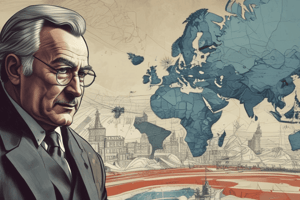Podcast
Questions and Answers
Match the following events with their corresponding years:
Match the following events with their corresponding years:
Berlin Blockade and Airlift = 1948-1949 Cuban Missile Crisis = 1962 Korean War = 1950-1953 Yalta Conference = 1945
Match the following ideologies with their respective countries:
Match the following ideologies with their respective countries:
Capitalist, democratic = US Communist, authoritarian = USSR Mixed economy, democratic = None Theocratic, authoritarian = None
Match the following policies with their respective purposes:
Match the following policies with their respective purposes:
Truman Doctrine = Providing economic and military aid to countries threatened by communism Marshall Plan = Rebuilding war-torn Europe Containment Policy = Preventing Soviet expansion into Eastern Europe NATO = Forming a military alliance with European countries
Match the following conflicts with their respective regions:
Match the following conflicts with their respective regions:
Match the following speeches with their respective speakers:
Match the following speeches with their respective speakers:
Match the following organizations with their respective purposes:
Match the following organizations with their respective purposes:
Match the following events with their respective outcomes:
Match the following events with their respective outcomes:
Match the following reforms with their respective leaders:
Match the following reforms with their respective leaders:
Flashcards are hidden until you start studying
Study Notes
Definition and Duration
- The Cold War was a period of geopolitical tension and rivalry between the United States and the Soviet Union from 1947 to 1991.
- It was a "cold" war because it did not involve direct military conflict between the two superpowers.
Causes of the Cold War
- Post-WWII ideologies: US (capitalist, democratic) vs. USSR (communist, authoritarian)
- Soviet Union's expansion into Eastern Europe and the US's response to contain it
- Yalta Conference (1945): disagreements over post-war reorganization and spheres of influence
- Truman Doctrine (1947): US policy of providing economic and military aid to countries threatened by communism
- Marshall Plan (1948): US economic aid to rebuild war-torn Europe, seen as a challenge to Soviet influence
Key Events
- Berlin Blockade and Airlift (1948-1949): Soviet Union's attempt to cut off West Berlin, countered by US-led airlift
- Korean War (1950-1953): conflict between North Korea (backed by China and USSR) and South Korea (backed by US and UN)
- Cuban Missile Crisis (1962): US-Soviet standoff over Soviet missile deployment in Cuba
- Vietnam War (1955-1975): US involvement in conflict between North and South Vietnam, seen as a proxy war against communism
Propaganda and Ideology
- Both sides engaged in propaganda campaigns to promote their ideologies and discredit the opponent
- The "Iron Curtain" speech by Winston Churchill (1946) and the "Evil Empire" speech by Ronald Reagan (1983) exemplified the ideological divide
Proxy Wars and Alliances
- The US and USSR supported different sides in various regional conflicts, such as:
- Greek Civil War (1946-1949)
- Angolan Civil War (1975-2002)
- Nicaraguan Revolution (1960-1990)
- NATO (1949) and the Warsaw Pact (1955) were formed as military alliances to counterbalance each other's influence
Détente and End of the Cold War
- Détente (1960s-1970s): period of reduced tension, marked by agreements like SALT I (1972) and the Helsinki Accords (1975)
- Mikhail Gorbachev's reforms (1980s): glasnost (openness) and perestroika (restructuring) led to the collapse of the Soviet Union in 1991
Definition and Duration
- The Cold War lasted from 1947 to 1991, characterized by geopolitical tension and rivalry between the US and the USSR.
- It was a "cold" war because it did not involve direct military conflict between the two superpowers.
Causes of the Cold War
- The conflict stemmed from post-WWII ideologies, with the US representing capitalism and democracy, and the USSR representing communism and authoritarianism.
- The Soviet Union's expansion into Eastern Europe and the US's response to contain it contributed to the Cold War.
- The Yalta Conference (1945) highlighted disagreements over post-war reorganization and spheres of influence.
- The Truman Doctrine (1947) and the Marshall Plan (1948) marked significant US policies to counter Soviet influence.
Key Events
- The Berlin Blockade and Airlift (1948-1949) saw the Soviet Union attempt to cut off West Berlin, countered by a US-led airlift.
- The Korean War (1950-1953) was a conflict between North Korea (backed by China and the USSR) and South Korea (backed by the US and UN).
- The Cuban Missile Crisis (1962) was a US-Soviet standoff over Soviet missile deployment in Cuba.
- The Vietnam War (1955-1975) was a US involvement in a conflict between North and South Vietnam, seen as a proxy war against communism.
Propaganda and Ideology
- Both sides engaged in propaganda campaigns to promote their ideologies and discredit the opponent.
- The "Iron Curtain" speech by Winston Churchill (1946) and the "Evil Empire" speech by Ronald Reagan (1983) exemplified the ideological divide.
Proxy Wars and Alliances
- The US and USSR supported different sides in various regional conflicts, including:
- Greek Civil War (1946-1949)
- Angolan Civil War (1975-2002)
- Nicaraguan Revolution (1960-1990)
- NATO (1949) and the Warsaw Pact (1955) were formed as military alliances to counterbalance each other's influence.
Détente and End of the Cold War
- The period of détente (1960s-1970s) saw reduced tension, marked by agreements like SALT I (1972) and the Helsinki Accords (1975).
- Mikhail Gorbachev's reforms (1980s) led to the collapse of the Soviet Union in 1991, with glasnost (openness) and perestroika (restructuring) being key factors.
Studying That Suits You
Use AI to generate personalized quizzes and flashcards to suit your learning preferences.




